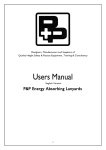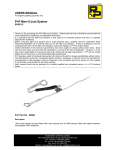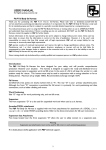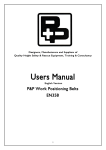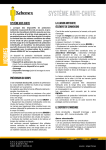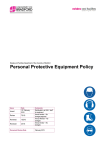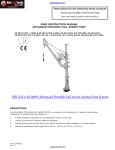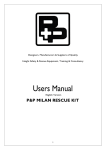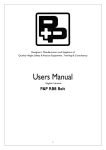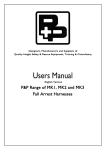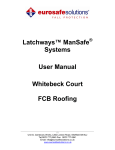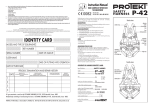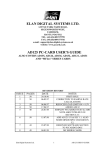Download online PDF manual
Transcript
Designers, Manufacturers and Suppliers of Quality Height Safety & Rescue Equipment, Training & Consultancy Users Manual English Version P&P Work Positioning & Restraint Lanyards EN358 & EN354 1 Thank you for purchasing this Lanyard. Please take time to familiarize yourself with the correct use and operation. It is imperative that this Lanyard is only used for its intended purpose and that it is subject to a periodic recorded detailed inspection by a competent person. To avoid personal injury, prior to using this Lanyard or training others to use it, CAREFULLY READ and understand these instructions. If there is anything you do not understand DO NOT use the Lanyard, contact the supplier or P&P for further details. Certain information in this manual is governed by law and is subject to change without prior notice. Great care has been taken to ensure that the information is correct at the time of publication. However, it is the user’s sole responsibility to ensure that they fully comply with all legal requirements. P&P will not accept liability for any inaccuracy or incorrectly stated legal requirements. P&P operate a policy of continual improvement and reserve the right to change specifications without notice. The Manufacturer and / or their recognised agents, directors, employees or insurers will not be held liable for consequential or other damages, losses or expenses in the connection with or by reason of or the inability to use the Lanyard for any other purpose. Note; training should only be delivered by a suitably qualified and competent person, i.e. a P&P products trainer. Description P&P Rope-Rat Work Positioning Lanyard A 2m lanyard constructed of 11mm Kernmantle rope with a ‘Rope-Rat’ adjuster and protective sleeve. One end of the Kernmantle rope is fitted with a Kwiklok Captive Eye Karabiner or other approved EN362 connector). The ‘Rope-Rat’ attachment point is normally supplied with a screwed oval link but may be fitted with a self closing/self locking EN362 connector. The free end of the rope is ‘sewn back’ to prevent the ‘Rope-Rat’ detaching from the rope end. Typically this lanyard is used with an EN361 harness fitted with EN358 attachment points. It then serves to provide a hands free environment. To adjust ‘up’ the working length of the lanyard, when the lanyard is in the position of work and connected to your harness, take your weight off the lanyard by using one hand to pull yourself in, then use your other hand to pull the free end of the rope. This will adjust ‘up’ the working length of the lanyard. To lengthen the lanyard, grasp the ‘Rope-Rat’ with your hand closest to it, partially support your weight with your other hand on the structure and depress the release lever with your finger. A lanyard is used to connect a safety harness, work positioning or restraint belt to an anchorage point, to hold the user in a supported work position or to prevent the user reaching a position where a fall is possible (restraint). It is not intended for fall arrest unless fitted with an energy absorber conforming to EN355. Work Positioning and Restraint Lanyards used for ‘Restraint’ should be of such a length or adjusted to such a length that a fall situation cannot occur. Lanyards used in ‘Work Positioning’ are designed to support the user when working at height and when needing a hands free environment. A fall arrest backup must be used if the user is not in ‘Restraint’ and there is a risk of a fall. Only EN354 lanyards may be used in conjunction with an energy absorber pack (fall arrest) and the overall length must not exceed 2m. Before Using P&P recommend that users are trained in the proper use and practical/physical limitations of this Lanyard. Equipment specifiers / users must ensure this device is used with compatible equipment and connectors. Failure to ensure compatibility may result in an unsafe condition or even connector/link failure. P&P Man-U-Just Work Positioning Lanyard A 2m lanyard constructed of 16mm Nylon rope with a ‘Man-U-Just’ rope adjuster and protective sleeve. One end of the Nylon rope is fitted with an aluminium double action ‘snap hook’. The ‘Man-U-Just’ attachment point is normally supplied with a screwed oval link but may be fitted with a self closing/self locking EN362 connector. The free end of the rope is ‘back spliced’ to prevent the ‘Man-U-Just detaching from the rope end. Typically this lanyard is used with an EN361 harness fitted with EN358 attachment points. It then serves to provide a hands free environment. The rope can be increased (loosened) or decreased Warning All work at height including the use of Personal Protective Equipment (PPE) as a control measure is subject to a suitable and sufficient risk assessment. P&P Work Positioning Lanyards P&P produce a range of ‘Work Positioning’ Lanyards to BSEN 358. These lanyards must be used with an approved harness or belt and will provide a work positioning or restraint system when used with a suitable anchorage. 2 (tightened) as required when in the work position. Note that both hands are needed to perform this adjustment and that the Work Positioning Lanyard must not be supporting your weight at the time. To alter the length, hold the free end of the rope with one hand and grasp the ‘Man-U-Just with the other hand, compressing the lever with the palm of your hand. This action will release the ‘Man-U-Just’s grip on the rope and allow you to move it in either direction to increase or decrease length. Once adjusted, release the lever and check it grips the rope. Webbing Lanyards P&P Webbing Work Positioning Lanyard (Pole Strap) A 2m lanyard constructed of polyester webbing with an adjustable buckle and wear pad to protect the webbing from abrasion. This standard pole strap is fitted with an aluminium double action ‘snap hook’ at each end (other connectors may be fitted conforming to EN362). This lanyard is only for use with the EN358 Work Positioning ‘D’ rings fitted to a suitable P&P harness. It then serves to provide a hands free environment. The Webbing Strap can be increased or decreased in length as required when in the work position. Note that only one hand is needed to perform this adjustment and that the Work Positioning Lanyard must not be supporting your weight at the time. To adjust ‘up’ the working length of the lanyard, when the lanyard is in the position of work and connected to your harness, take your weight off the lanyard by using one hand to pull yourself in, then use your other hand to pull the ‘Webbing Strap short end’ away from you. This will adjust ‘up’ the working length of the lanyard. To decrease length, grasp the long end of the webbing loop and pull it back. The following are examples of P&P Rope Lanyards and are constructed of 11mm Kernmantle Rope. They are available with a choice of EN362 end connectors (hooks and karabiners) and lengths up to 2m. Important Notes 1) Lanyards fitted with an adjuster are tested to EN358 and must ONLY be used for work positioning/restraint. They must NOT be used as part of, or incorporated in a fall arrest system. The connector at the adjuster end will NOT be made captive unless supplied with a ‘captive eye’ type connector. 2) A 0.5m lanyard fitted with a double action snap hook to fit over a ladder rung. This lanyard is only available in this length and if used as a ladder hook must not be extended. It must ONLY be used on fixed and secured ladders. Webbing & Rope Lanyards In addition to the Work Positioning Lanyards already discussed P&P produce a range of Webbing and Rope Lanyards that are suitable for work positioning, restraint or part of a fall arrest system. The following are examples of webbing lanyards and are constructed of 32mm 34kN breaking strain webbing. They are available with a choice of EN362 end connectors (hooks and karabiners) and lengths up to 2m. 81002NEW A 0.5m lanyard to EN354 fitted with a ‘D’ ring and screwed triangular link designed to extend a harness fall arrest attachment point. It must ONLY be used with a retractable type fall arrestor (EN360) incorporating an automatic tensioning spring. Connect the screwed triangular link directly to your harness fall arrest ‘D’ ring. Connect 3 • the lanyard ‘D’ ring to the retractable type fall arrestor connector. Always ensure the lanyard is kept under tension and never allowed to become slack. This lanyard makes the connection of a retractable type fall arrestor easier and in the event of a rescue, provides a ‘cut’ section in the life line. • Usage • • • • • These items of PPE are for personal use only Only use connectors (hooks, karabiners etc) approved and recommended by P&P. Check the Inspection Record for this lanyard to ensure that regular inspections have been correctly recorded. It is strongly recommended that the user is given adequate practical training prior to using this lanyard or any other P&P product. The Maximum Rated Load (user weight) for P&P work positioning and restraint lanyards is 150Kg. In all cases when determining the suitability of equipment, specifiers should consider both the position and strength of anchorages. Under no circumstances use this lanyard where a fall can occur. If a fall can occur then a backup fall arrest system MUST be used. • • • Connector Loading • • • • • • Do not use this lanyard until you have read and fully understood these instructions. Do not use this lanyard for ‘Work Positioning/ Restraint’, unless it is of such a length or can be adjusted to such a length that a fall cannot occur. Do not anchor to a structure that itself can fall i.e. freestanding ladder or any loose structure. Do not loop standard lanyards around objects with sharp edges. If a lanyard is to be looped around a structure (choked), a protective sleeve should be fitted. Do not tie a knot in a lanyard to make it shorter, it can reduce the lanyard strength by 50% Do not connect to an energy absorber if the finished length is greater than 2m Do not use an EN358 lanyard to make up a fall arrest lanyard using an Energy Absorber Pack. Correct loading with gate mechanism secured shut. Incorrect loading. It is strongly recommended that users are trained in its proper use and practical/physical limitations. Modifications and Repairs No repairs, modifications or alterations are to be carried out on this Lanyard. Marking of PPE Textile products including webbing and rope must not be marked using ink or paint. Marker pens and paint will contaminate textile fibres leading to potential damage from material stiffening or even chemical attack. Plastic or Metal casings of components must not be marked by stamping, etching or engraving. These processes may weaken the material or damage protective coatings. P&P advise that if additional identification is required a tagging system (label or electronic) should be used that does not interfere in any way with the operation of IF IN DOUBT, CONTACT YOUR SUPPLIER OR P&P FOR ADVICE. Do • * Important Do not • Do ensure that this lanyard is connected to the correct attachment point of the full body harness or belt. If used as part of a fall arrest system then only the Sternum ‘D’ ring or Dorsal ‘D’ ring (Fall arrest points marked with letter ‘A’) Do ensure that the closing mechanism of the connector(s) is locked shut. Kwiklock, Locksafe and double action snap hook types do this automatically but should still be checked. Screw gate types must be screwed manually and checked by applying pressure against the closing mechanism. Do ensure if this lanyard is used for ‘Work Positioning at Height’ where a fall is possible there is a ‘Backup’ fall arrest system. Do ensure the connector, karabiner or snap-hook is loaded along its major axis. Be aware of ‘cross gate loading’. A karabiner is engineered to ‘direct’ force along its major axis – but still check! * Do ensure this lanyard is only used with compatible connectors. Do ensure that the lanyard is connected to an anchorage of sufficient strength. Fall arrest – minimum peak load 12kN. Restraint/Work Positioning – minimum peak load capacity 3kN. 4 equipment or devices. Contact P&P or your supplier for advice on additional labelling. water – if still soiled; wash in clean warm water (40ºC max) using a mild detergent if necessary. Thoroughly rinse in clean cold water and dry as described above. Rescue Plan Chemical Attack Rescue Plan As part of your risk assessment you MUST have in place a rescue plan to deal with any emergency, which may occur during use. Access to the user, directly or indirectly and their safe retrieval is of paramount importance, including preparations for dealing with potential Post Fall Suspension Syncope Avoid contact with any chemical, which might affect the performance of this lanyard, e.g these include all acids and strong caustic substances (vehicle battery acid, bleach etc) If subject to chemical attack, you must remove it from service and check with the supplier or P&P for advice on the possible consequence of chemical degradation. Inspection Check your Lanyard for any damage or malfunction prior to each and every use. If there is any doubt about the safe condition of the lanyard, it should be immediately withdrawn from use and inspected by a competent person or returned to the supplier/manufacturer. This manual contains a section for recording Detailed Inspections. On the back page of the manual is a space for the user to record the product name, serial number and date of manufacture. Detailed Recorded Inspections should only be carried out by a competent person, appointed by the employer. Additional, recorded interim inspections may be required where risks from transient arduous working conditions exist. This should be identified through risk assessment. These recorded inspections must be carried out at least every 12 months as a requirement of EN365; however in the UK the HSE would like all fall prevention PPE to have a Detailed Recorded Inspection every 6 months. The pre-use check must include (but is not limited to) • Check all webbing/rope for signs of cuts, abrasions, fraying, tears, burns, mould, discolouration or chemical attack. • Check all stitching for signs of loosening, pulling or cut thread. There must be no evidence of damaged stitching on either side of the stitch pattern. • If the lanyard has been subject to significant paint overspray, it must not be used. • Check connectors for correct operation ensuring there is no tendency for them to stick or jam. • Adjusters and connectors must be free from rust, excessive wear, distortion or cracks. If during the pre-use check the lanyard is found to be or believed to be faulty DO NOT use it. Remove from site to ensure it cannot be used by anyone else. Storage After any necessary cleaning, dry completely then store in a cool dry place, which will protect it from extreme humidity and direct heat. Transportation Care should be taken to protect the lanyard against risks such as those detailed under Service Life. A simple effective way is to transport the lanyard in a suitable bag or container, which prevents abrasion. Service Life The Lanyard has a maximum life span of 10 years from date of manufacture, provided it is correctly stored and maintained. However, if the lanyard fails any inspection it MUST be destroyed. See the Statement of Obsolescence within this manual. About This Manual This User Manual is for English speaking countries only. If you require this manual in a different language, please Contact P&P. When this item is sold on, this manual must accompany it and be supplied in the language of the destination country. Product Details The Product Code, Serial number and Date of Manufacture of the Lanyard should be entered on the back page of this manual for future reference and inspection purposes. Warning This Lanyard must be used by persons who are medically fit to do so. If you have any medical condition, are recovering from any medical condition or suffer from any physical or mental disability you must seek professional medical advice before using this Lanyard. Cleaning, Maintenance and Storage Keep the Lanyard clean and dry. Remove excess moisture with a clean cloth then allow drying naturally in a warm room away from direct heat. You may clean this lanyard using water but avoid getting soap/detergent into buckles. First rinse in clean cold 5 Statement of Obsolescence Due to the ingress of dirt and grit, chemical contamination, edge and surface damage, ultraviolet light degradation, and wear and tear, Fall Protection Equipment manufactured from synthetic fibres (webbing and/or rope) is subject to a manufacturer’s statement of obsolescence, which is a requirement of BS EN 365:2004 a European Product Standard. Any item of Fall Protection Equipment manufactured by P&P with synthetic fibre components (webbing and/or rope) is subject to maximum life span of 10 years from date of manufacture, provided that the item has been correctly stored, maintained and subjected to regular recorded inspections by a trained and competent person. However, if the item fails any inspection, it MUST immediately be withdrawn from service and destroyed. An item of Fall Protection Equipment incorporating synthetic fibre components (webbing and/or rope), manufactured by P&P after January 2015, which has been subject to a lifetime recorded inspection plan, may give a maximum life span of 10 years. The lifetime recorded inspection plan must be continuous from date of first use and be undertaken by a competent person appointed by the employer. Competent persons must be trained in the use and inspection of the equipment. The lifetime inspection plan must include as a minimum requirement, a pre use check and 6 monthly recorded inspections. The frequency of inspections should be determined by risk assessment, use and environmental conditions. Reference should also be made to the British Standard BS 8437:2005 – ‘The code of practice selection, use and maintenance of personal fall protection systems and equipment for use in the workplace’ - clause 13.2 Lifespan, which states: ‘Some equipment is given a life span or obsolescence date by the manufacturer. Equipment that has reached such a limit, which has not already been rejected for other reasons, should be withdrawn from service and not used again, unless or until confirmed by a competent person, in writing, that it is acceptable to do so.’ It should be noted that inspections carried out by a trained and competent person are only visual and tactile observations of the condition of the product; they are not testing the residual strength of the equipment. All synthetic fibres deteriorate slowly with age regardless of use and as a result, P&P strongly advises all users of Fall Protection Equipment to follow the manufacturer's statement of obsolescence. For further advice on this statement, as well as training in the use and inspection of Fall Protection Equipment, please contact P&P 6 7 Designers, Manufacturers and Suppliers of Quality Height Safety & Rescue Equipment, Training & Consultancy EC DECLARATION OF CONFORMITY The Manufacturer in the Community P&P Limited, 131 New John Street, Aston, Birmingham B6 4LD United Kingdom Declares that the PPE described hereafter as the Work Positioning & Restraint Lanyards is in conformity with the provisions of Council Directive 89/686/EEC and where such is the case, with the national standard transposing harmonizing standard numbers: either BSEN 358:2000 or BSEN 354:2002 is identical to the PPE which is subject to EC certificate of conformity number Rope-Rat BSEN 358/06/002 dated March 2007 Man-U-Just BSEN 358/95/001dated January 1995 amended AD135 December 2010 Webbing WP Lanyard BSEN 358/94/002 dated 20 December 1994 amended AD 136 December 2010 BSEN 354/95/002 dated 17/03/95 amended by Extension Certificate AD138 dated 25/01/2011 issued by TUV NEL Limited, East Kilbride, Glasgow, G75 0QU, United Kingdom EC Notified Body No 0320 is subject to the procedures set out in Article 11 point B of Directive 89/686/EEC under the supervision of the approved body: The British Standards Institute, 389 Chiswick High Road, London W4 4AL, United Kingdom EC Notified Body No 0086 Done at Birmingham, United Kingdom on 14 May 2015 Senior Technical Manager PRODUCT NAME:………………………………. PRODUCT CODE:………………………………. SERIAL NUMBER:………………………………... DATE OF MANUFACTURE:……………………. P&P Limited, 131 New John Street, Aston, Birmingham B6 4LD, England. Telephone: 0121 359 4561 Facsimile: 0121 359 4136 Email: [email protected] Website: www.ppsafety.co.uk This Manual and its contents © P&P Limited 2015 Work Positioning & Restraint Lanyards V 3_0515 All rights reserved. No part of this publication may be reproduced, stored in a retrieval system, or transmitted, in any form or by any means, electronic, mechanical, photocopying, recording or otherwise, without the prior permission of P&P Limited. P&P Limited, 131 New John Street, Aston, Birmingham B6 4LD, England. Tel: +44 (0)121 359 4561 Facsimile: +44 (0)121 359 4136 e-mail: [email protected] website: www.ppsafety.co.uk Registered in England No. 01493537 8








